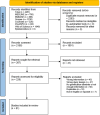Gamification Integration in Technological Devices for Motor Rehabilitation in Parkinson Disease: Scoping Review
- PMID: 40614259
- PMCID: PMC12252148
- DOI: 10.2196/69433
Gamification Integration in Technological Devices for Motor Rehabilitation in Parkinson Disease: Scoping Review
Abstract
Background: Parkinson disease (PD) is a rapidly growing neurological condition worldwide. While physiotherapy and exercise are effective interventions, the addition of motivational aspects that improve adherence could be beneficial for people with PD. Incorporating technological devices into motor rehabilitation, coupled with gamification elements, could enhance the relevance of rehabilitation and alleviate motor symptoms.
Objective: The aim of this scoping review was to identify and classify the technological devices that integrate gamification elements used in motor rehabilitation in PD, and to describe the justification behind the use of these devices and elements in this context.
Methods: We conducted a scoping review following the framework proposed by Joanna Briggs Institute, along with the PRISMA-ScR (Preferred Reporting Items for Systematic Reviews and Meta-Analyses Extension for Scoping Reviews) guidelines. Major health science databases (MEDLINE, EMBASE, Scopus, Cochrane, Web of Science, PsycINFO, and Epistemonikos) were systematically searched. Relevant studies were included if they used technological interventions with gamification elements for motor symptom rehabilitation in PD. Gamification elements were extracted and categorized based on established frameworks, and content analysis was used to review the justifications for the use of technologies integrating gamification.
Results: A total of 4451 studies were retrieved from the search. After the abstract and full-text screening, 81 studies were eligible for data extraction. The analysis identified 453 gamification elements across studies, with development and accomplishment being the most prominent core drive. Progress/feedback was the most frequently used element (79/81, 98% of studies), followed by points (70/81, 86%) and levels/progression (66/81, 81%). Other notable elements included badges, leaderboards, and customization, while several core drives, like ownership and possession, lacked reported elements. Most interventions were delivered through commercial video game consoles (33/81, 41%), followed by computer-based systems (32/81, 40%). Tablet-based applications and integrated rehabilitation platforms were used in 11% (9/81) and 10% (8/81) of the studies, respectively. The expected roles of technology were clear, but intentional use of gamification was scarce.
Conclusions: This scoping review highlights the widespread adoption of technologies integrating gamification elements for motor symptom rehabilitation in individuals with PD. However, it also underscores a critical gap in understanding and justifying gamification mechanics. The current landscape relies heavily on commercial video games and emphasizes performance-based experiences, lacking theoretical grounding.
Keywords: Parkinson disease; gamification; motor rehabilitation; physiotherapy; rehabilitation.
© Pere Bosch-Barceló, Oriol Martínez-Navarro, Maria Masbernat-Almenara, Carlos Tersa-Miralles, Anni Pakarinen, Helena Fernández-Lago. Originally published in JMIR Serious Games (https://games.jmir.org).
Conflict of interest statement
Figures
Similar articles
-
Factors that influence participation in physical activity for people with bipolar disorder: a synthesis of qualitative evidence.Cochrane Database Syst Rev. 2024 Jun 4;6(6):CD013557. doi: 10.1002/14651858.CD013557.pub2. Cochrane Database Syst Rev. 2024. PMID: 38837220 Free PMC article. Review.
-
Health professionals' experience of teamwork education in acute hospital settings: a systematic review of qualitative literature.JBI Database System Rev Implement Rep. 2016 Apr;14(4):96-137. doi: 10.11124/JBISRIR-2016-1843. JBI Database System Rev Implement Rep. 2016. PMID: 27532314
-
Factors that impact on the use of mechanical ventilation weaning protocols in critically ill adults and children: a qualitative evidence-synthesis.Cochrane Database Syst Rev. 2016 Oct 4;10(10):CD011812. doi: 10.1002/14651858.CD011812.pub2. Cochrane Database Syst Rev. 2016. PMID: 27699783 Free PMC article.
-
Home treatment for mental health problems: a systematic review.Health Technol Assess. 2001;5(15):1-139. doi: 10.3310/hta5150. Health Technol Assess. 2001. PMID: 11532236
-
The Effects of mHealth-Based Gamification Interventions on Participation in Physical Activity: Systematic Review.JMIR Mhealth Uhealth. 2022 Feb 3;10(2):e27794. doi: 10.2196/27794. JMIR Mhealth Uhealth. 2022. PMID: 35113034 Free PMC article.
Cited by
-
Acupuncture modulates the microbiota-gut-brain axis: a new strategy for Parkinson's disease treatment.Front Aging Neurosci. 2025 Aug 7;17:1640389. doi: 10.3389/fnagi.2025.1640389. eCollection 2025. Front Aging Neurosci. 2025. PMID: 40851666 Free PMC article. Review.
References
Publication types
LinkOut - more resources
Full Text Sources
Miscellaneous



